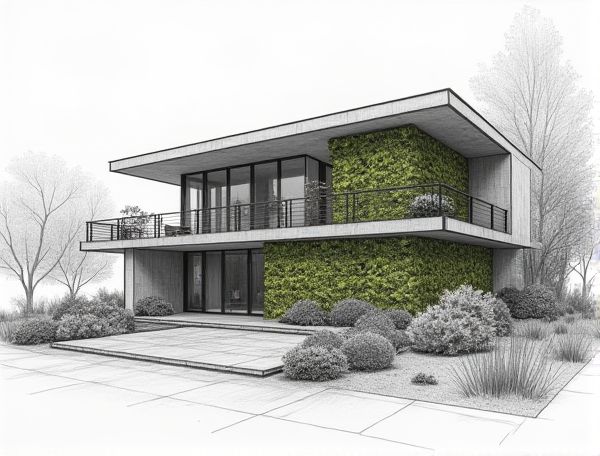
Photo illustration: Biophilic home design with hydroponic wall systems
Integrating hydroponic wall systems into biophilic home design enhances indoor air quality and brings nature's calming presence directly into your living space. Discover how this innovative approach transforms your home environment by reading more in the article.
Introduction to Biophilic Home Design
Biophilic home design integrates natural elements such as sunlight, greenery, and organic materials to enhance well-being and create a harmonious living environment. Incorporating features like indoor plants, natural textures, and ample natural light fosters a connection to nature that improves mental health and indoor air quality.
The Science Behind Biophilia and Wellbeing
Biophilia, the innate human affinity for nature, enhances wellbeing by reducing stress levels and improving cognitive function through exposure to natural elements in home design. Incorporating features such as indoor plants, natural light, and organic materials fosters a healthier living environment that promotes mental clarity and emotional balance.
What Are Hydroponic Wall Systems?
Hydroponic wall systems are innovative setups that allow plants to grow vertically without soil by using nutrient-rich water solutions. These systems maximize space efficiency and provide a sustainable way to incorporate greenery into your home design, improving air quality and aesthetic appeal. By installing a hydroponic wall system, you can easily maintain a lush indoor garden that requires less water and fewer resources than traditional soil-based planting.
Benefits of Integrating Hydroponics in Interior Spaces
Integrating hydroponics in interior spaces enhances air quality by increasing oxygen levels and reducing indoor pollutants, promoting a healthier living environment. You can enjoy year-round fresh herbs and vegetables without soil, saving space and minimizing water usage through this sustainable gardening method.
Key Components of a Hydroponic Wall System
Key components of a hydroponic wall system include a nutrient-rich water reservoir, a durable and lightweight frame, efficient water circulation pumps, and grow trays or panels that hold the plants securely. Your system also requires a lighting setup optimized for indoor growth and a growing medium that supports roots while allowing water and oxygen flow.
Design Considerations for Biophilic Homes
Integrating natural elements such as abundant greenery, natural light, and organic materials enhances air quality and promotes mental well-being in biophilic homes. Your living spaces can benefit from thoughtful design choices that connect indoor environments with the outdoors, fostering a harmonious and healthy atmosphere.
Plant Selection for Hydroponic Living Walls
Choosing the right plants for hydroponic living walls enhances air quality and maximizes space efficiency in your home design. Opt for low-maintenance, humidity-loving species like pothos, ferns, and philodendrons, which thrive in nutrient-rich water environments. Your plant selection directly impacts the vibrancy and health of the living wall, creating a dynamic, natural focal point indoors.
Installation and Maintenance Best Practices
Proper installation of HVAC systems ensures optimal airflow and energy efficiency, reducing long-term operational costs and preventing frequent repairs. Regular maintenance, including filter replacement and system inspections, extends equipment lifespan and maintains indoor air quality.
Energy Efficiency and Sustainability Factors
Incorporating energy-efficient insulation and high-performance windows significantly reduces heating and cooling demands, enhancing overall sustainability in home design. Utilizing renewable energy systems such as solar panels lowers carbon footprints while decreasing utility costs. Integrating sustainable materials like reclaimed wood and low-VOC paints further promotes eco-friendly living environments.
Inspiring Biophilic Home Design Case Studies
Inspiring biophilic home design case studies demonstrate how integrating natural elements like indoor gardens, natural light, and organic materials enhances well-being and connection to nature. Your space transforms into a serene sanctuary by prioritizing greenery, sustainable resources, and open layouts that promote harmony between indoors and outdoors.
 homedesy.com
homedesy.com